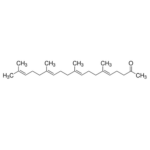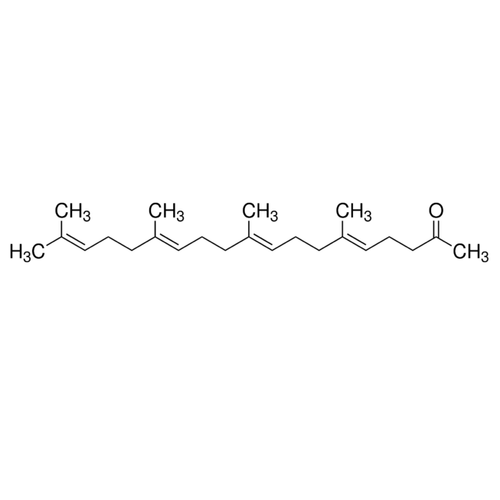| Product Name | Teprenone |
| Description |
HSP70 Inducer |
| Purity | >95% (GC) |
| CAS No. | 6809-52-5 |
| Molecular Formula | C23H38O |
| Molecular Weight | 330.6 |
| Field of Use | Not for use in humans. Not for use in diagnostics or therapeutics. For in vitro research use only. |
Properties
| Storage Temperature | -20ºC |
| Shipping Temperature | Shipped Ambient |
| Product Type | Inducer |
| Solubility | Soluble in DMSO (30 mg/ml) |
| Source | Synthetic |
| Appearance | Colorless Oil |
| SMILES | CC(=CCC/C(=C/CC/C(=C/CC/C(=C/CCC(=O)C)/C)/C)/C)C |
| InChI | InChI=1S/C23H38O/c1-19(2)11-7-12-20(3)13-8-14-21(4)15-9-16-22(5)17-10-18-23(6)24/h11,13,15,17H,7-10,12,14,16,18H2,1-6H3/b20-13+,21-15+,22-17+ |
| InChIKey | HUCXKZBETONXFO-NJFMWZAGSA-N |
| Safety Phrases |
Classification: Not a hazardous substance or mixture. Safety Phrases: S22 - Do not breathe dust. S24/25 - Avoid contact with skin and eyes. S36/37/39 - Wear suitable protective clothing, gloves and eye/face protection. |
| Cite This Product | Teprenone (StressMarq Biosciences Inc., Victoria BC CANADA, Catalog # SIH-526) |
Biological Description
| Alternative Names | Geranylgeranylacetone, GGA, 6,10,14,18-Tetramethyl-5,9,13,17-nonadecatetraen-2-one |
| Research Areas | Cancer, Cell Signaling, Heat Shock, Neuroscience |
| PubChem ID | 5282199 |
| Scientific Background | Teprenone is a cytoprotective agent known for its ability to induce heat shock proteins (HSPs), notably HSP70, HSPB8, and HSPB1. In neurodegenerative disease research, Teprenone has shown promise by reducing the formation of amyloid oligomers and insoluble aggregates, which are key pathological features in disorders such as Alzheimer's and spinal and bulbar muscular atrophy. Its neuroprotective effects are attributed to the upregulation of HSPs, which help maintain protein homeostasis and reduce cellular stress. Teprenone’s ability to cross the blood-brain barrier and modulate stress response pathways positions it as a potential therapeutic candidate in neurodegeneration and neuroinflammation. |
| References |
1. Kobayashi T., Ohta Y., Yoshino J and Nakazawa S. (2001) Pharmacol Res. 43(1): 23-30. 2. Sambroski P., Grzymislawski M. (2015) Adv Clin Med. 24(3): 525-530. 3. Marunouchi T., Inomata S., Sanbe A., Takagi N., Tanonaka K. (2014) Eur J Pharmacol. 730: 1401-47. 4. Sanbe A., et al. (2009) PLoS One. 4(4): e5351. |



Reviews
There are no reviews yet.